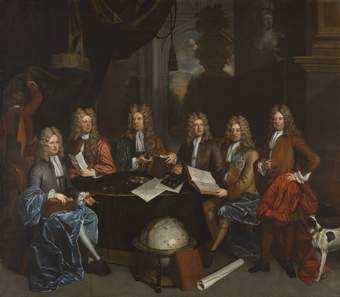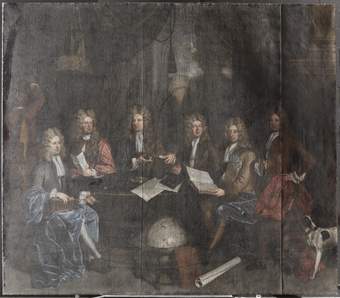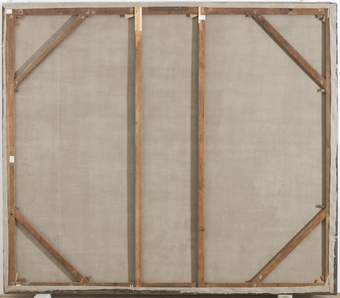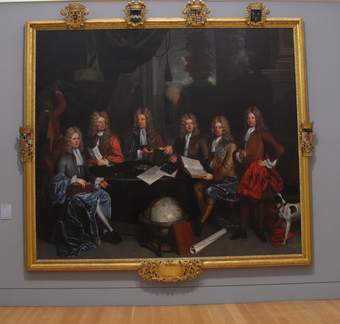
Fig.1
John James Baker active c.1685–1725
The Whig Junto 1710
Oil paint on canvas
3190 x 3649 x 37
T15046

Fig.2
The Whig Junto in raking light from the left side

Fig.3
Reverse of The Whig Junto
The painting (fig.1) is in oil on a heavy-weight canvas with double threads in both directions. Three pieces of canvas were joined vertically to create its large support: the two on the left appear to be their full natural width,1 while that on the right is approximately one third of the width of the other two strips (fig.2). In 2016 and before arrival at Tate it was hand lined for the first time to a fairly thick linen canvas using BEVA-371, a synthetic adhesive. It is seemingly attached to its original wooden stretcher (fig.3).
There are some small losses of paint that have been retouched and several areas where the fairly thinly applied paint is worn and reveals the light brown ground, some of which have been strengthened by retouching. Some areas such as the grey floor at the bottom are likely to be either reworked or retouched. The colours remain generally vibrant. Some of the blue glazes have lost colour, but where mixed with white the blues are in quite good condition. There are a few drying defects in the pale blue sash of the figure second from the right.
The 2016 treatment before its arrival at Tate included removal of the existing varnish and surface dirt upon it. This revealed a signature and date at lower left: ‘J. J. Baker 1710’. A varnish made of the stable acrylic material Paraloid B-72 was applied prior to retouching of losses in the same medium, and then a final varnish of Laropal aldehyde resin was applied, to give a slightly glossy appearance. These synthetic varnishes have sunk slightly in some of the darker areas at the top.

Fig.4
The Whig Junto displayed at Tate Britain in its frame, following frame conservation treatment
There is a carved and gilded frame (fig.4) with six carved, gilded and painted heraldic devices – belonging to the six sitters in the painting. The painted parts of the devices may have had their gilded areas re-gilded. A foliate cartouche, designed for an inscription (but blank) is attached at the centre of the bottom rail. The dimensions of the frame, with the heraldic crests attached, are approximately 3800 x 4005 x 210 mm. Three hand-forged hanging rings contemporary to the frame are attached with nailed-on plates along the rear of the top member of the frame.
March 2022
